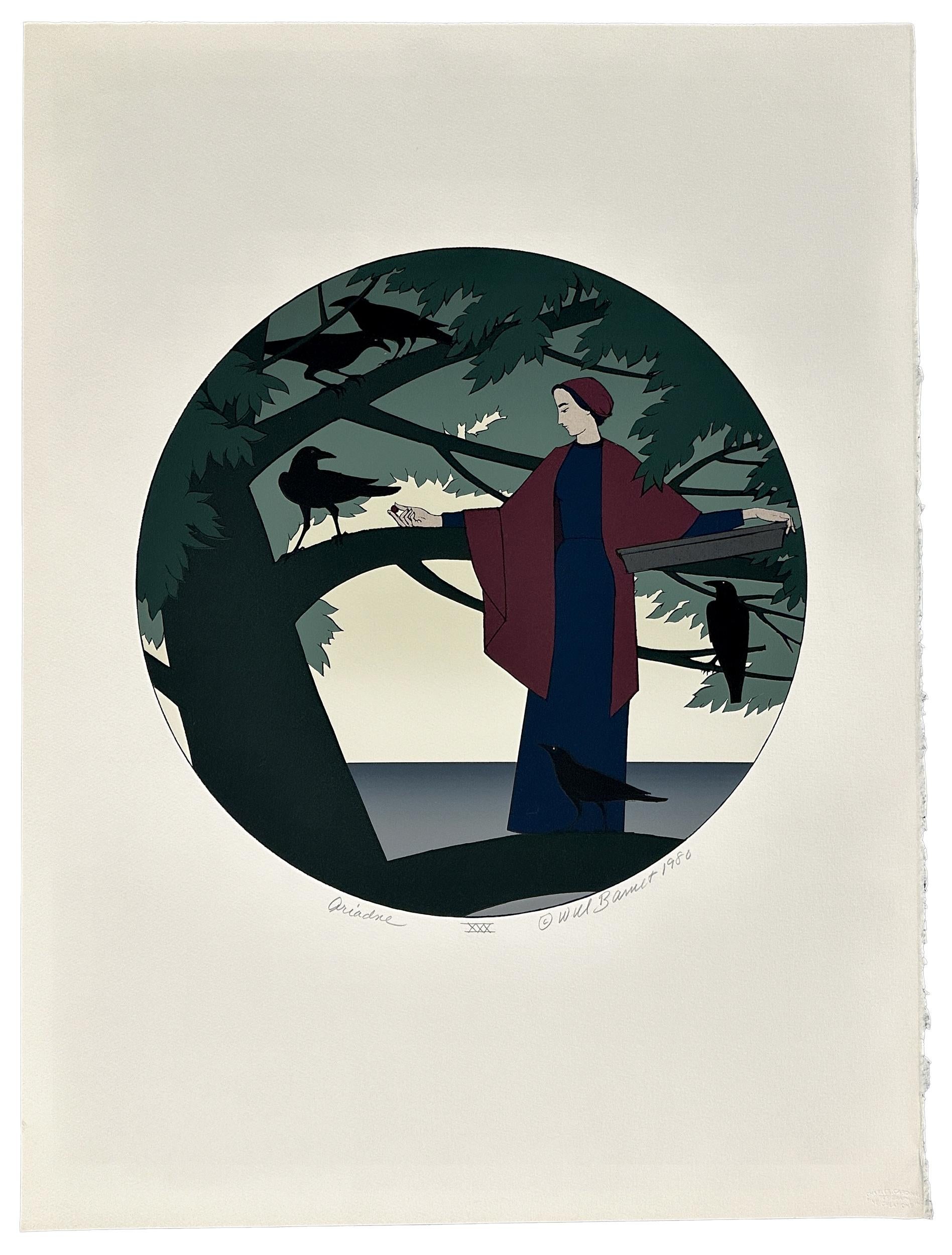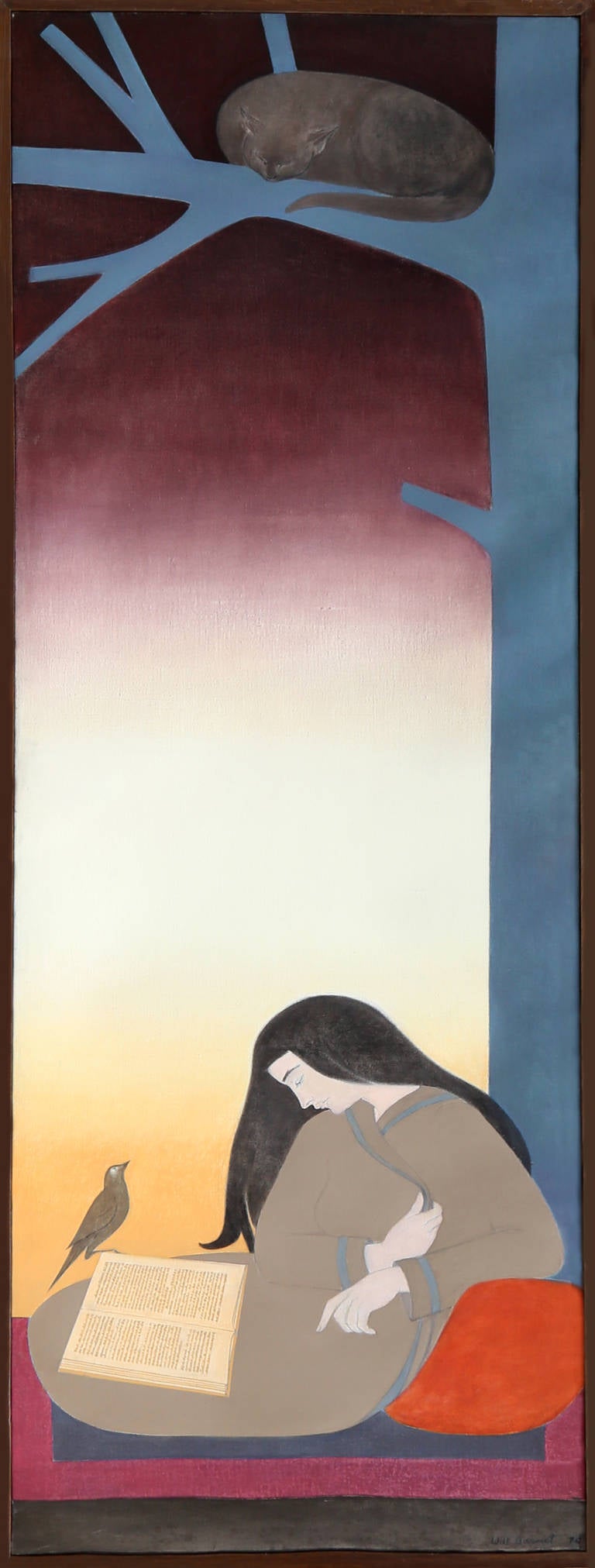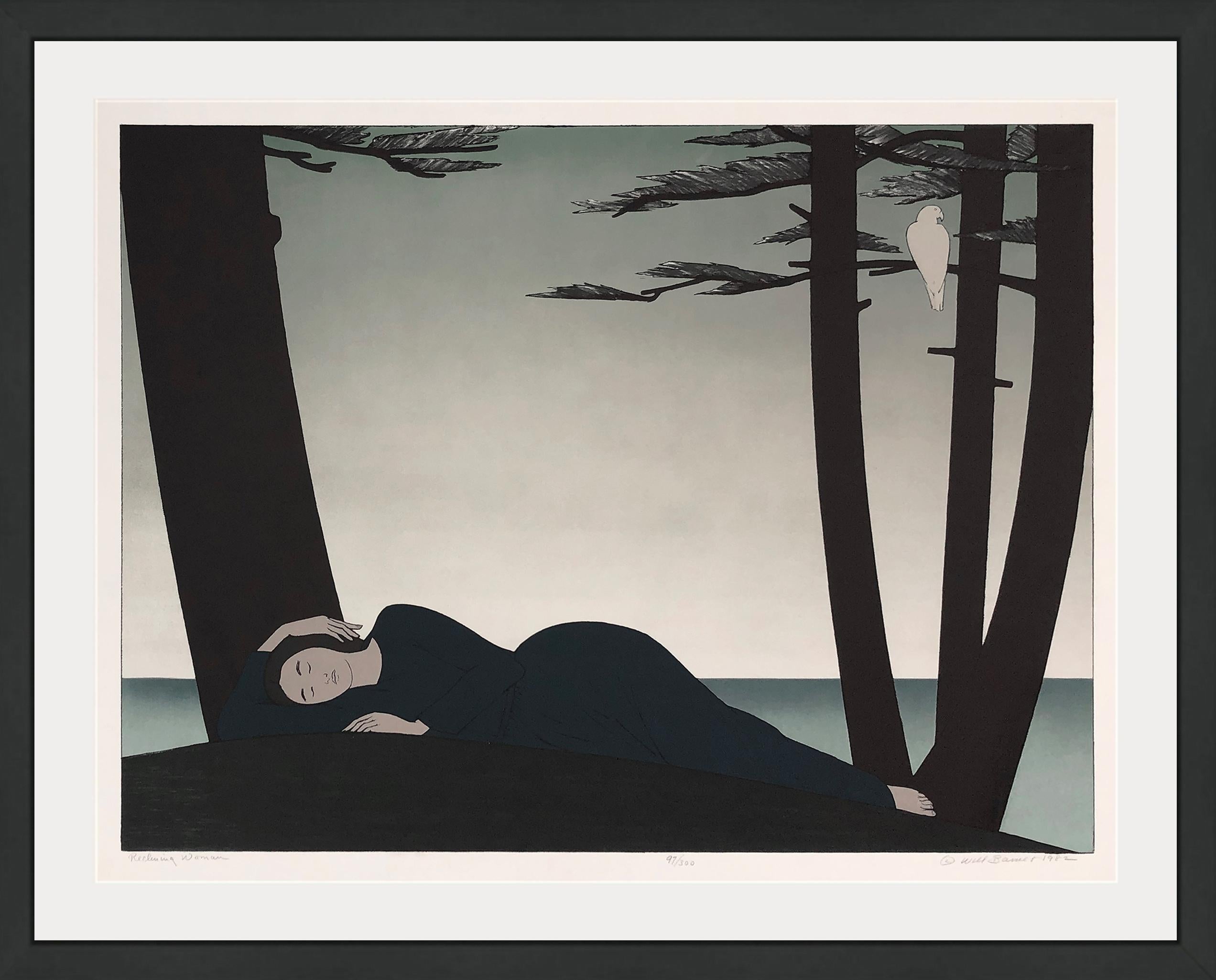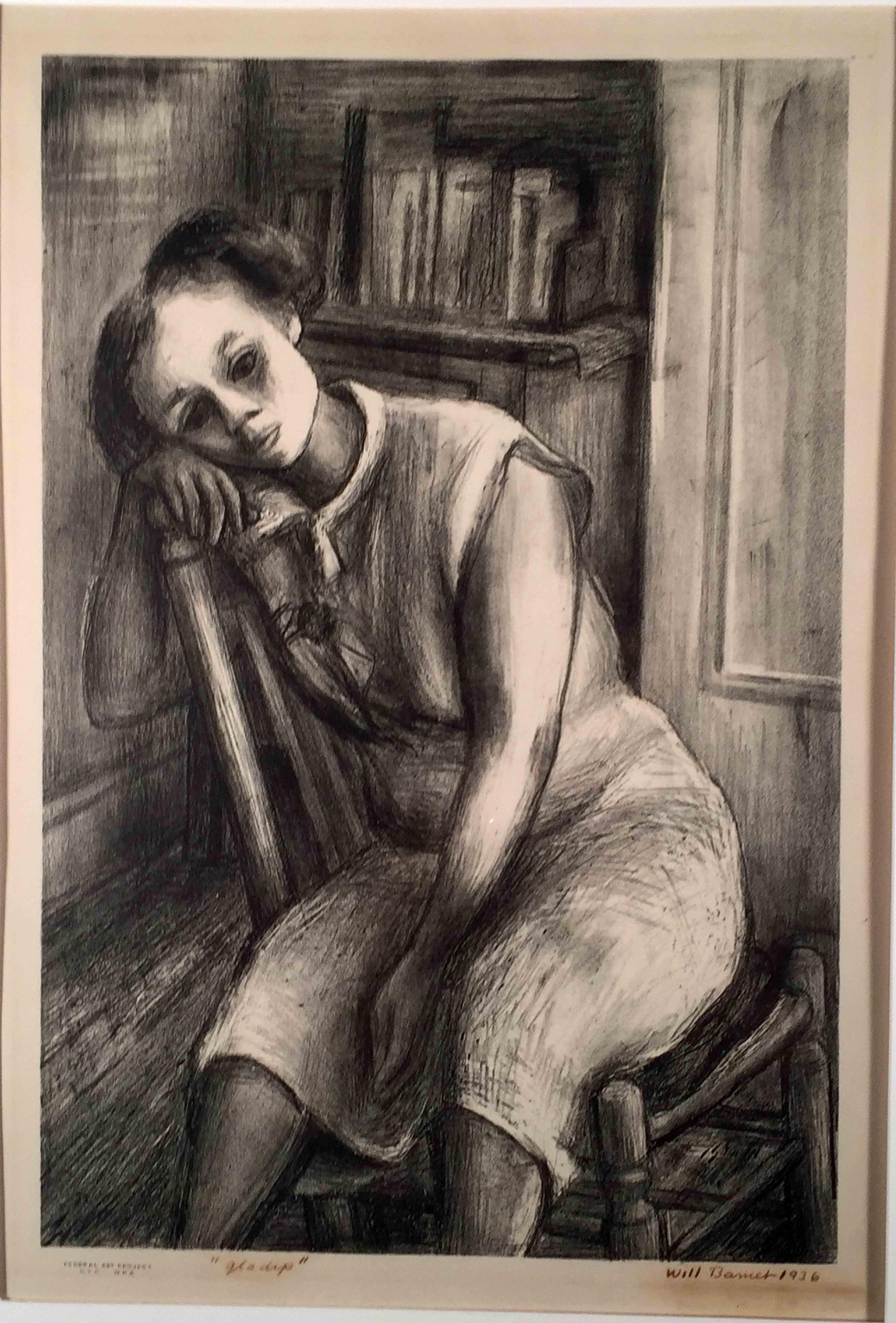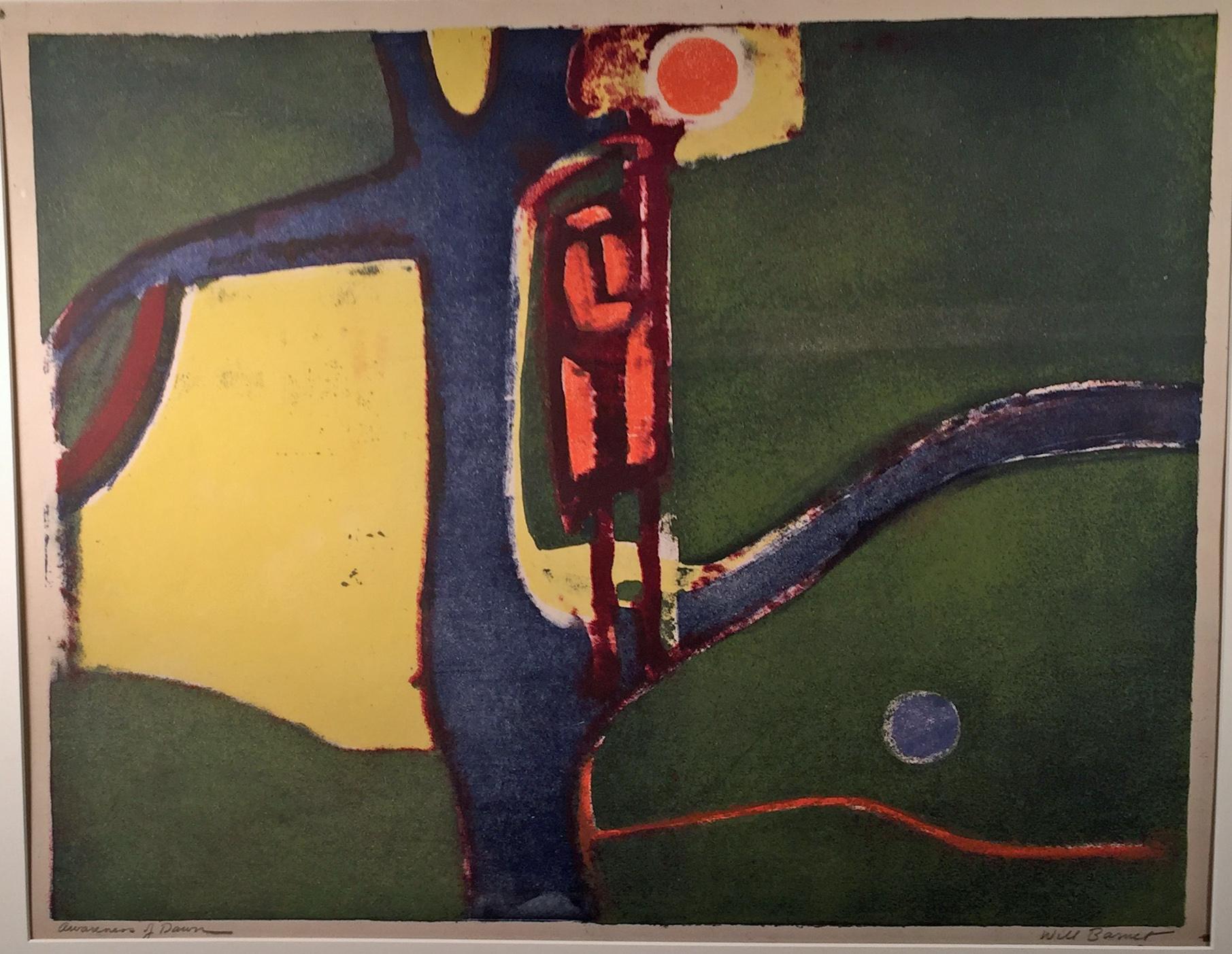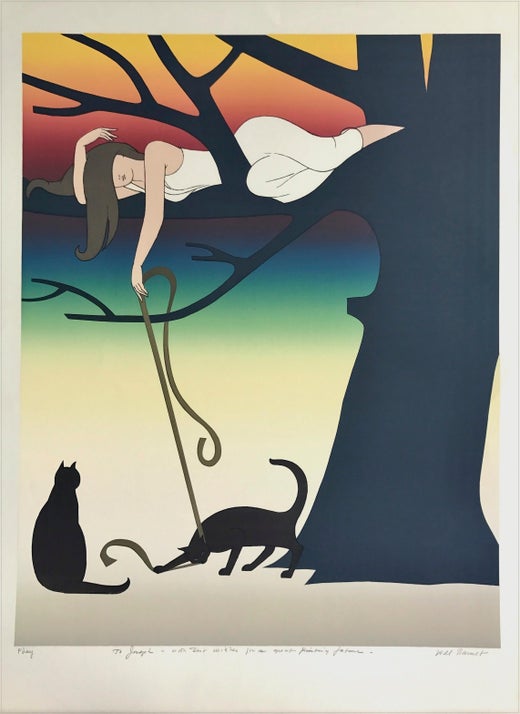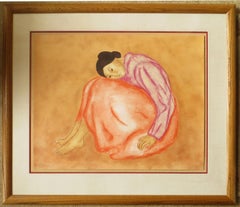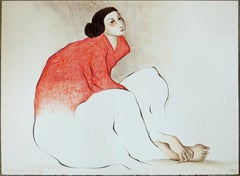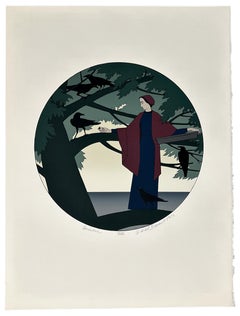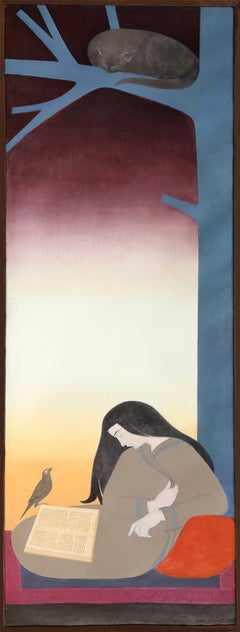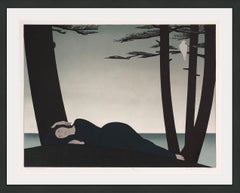Want more images or videos?
Request additional images or videos from the seller
1 of 11
Will BarnetCirce 21979
1979
$1,800
£1,372.13
€1,567.56
CA$2,532.85
A$2,774.26
CHF 1,460.65
MX$33,109.87
NOK 18,614.65
SEK 17,016.60
DKK 11,713.86
About the Item
This artwork titled "Circe" 1979 is an original colors serigraph on Wove paper by noted American artist Will Barnet, 1911-2012. It is hand signed, titled and numbered 43/100 in pencil by the artist. The image size (circle) is 18 x 18 inches, sheet size is 23.25 x 24 inches. It is in excellent condition, has never been framed.
About the artist:
Born in 1911 in Beverly, Massachusetts, Barnet knew by the age of ten that he wanted to be an artist. As a student, he studied with Philip Leslie Hale at the School of the Museum of Fine Arts, Boston and viewed first-hand John Singer Sargent at work on the murals of the Boston Public Library. In 1930, Barnet studied at the Art Students League of New York, with Stuart Davis and Charles Locke, beginning his long association with the school. Here he concentrated on painting as well as printmaking, and, in 1936, he became the official printer for the Art Students League. There, he later instructed students in the graphic arts at the school and taught alongside the likes of Yasuo Kuniyoshi, Robert Beverly Hale and Richard Pousette-Dart. Barnet influenced a generation of artists, including James Rosenquist, Knox Martin, Emil Milan, Paul Jenkins, Ethel Fisher and Cy Twombly.[3] Barnet continued his love of teaching with positions at the Cooper Union, at Yale University, and at the Pennsylvania Academy of Fine Arts. He was represented by the Bertha Schaefer Gallery in New York City.[4] Barnet had three sons, Peter, Richard, and Todd Barnet, by his first wife Mary Sinclair. Barnet later married Elena Barnet, with whom he had a daughter, Ona Barnet.
Barnett's works span the various "movements" of their era, from his early social realist work to his final signature style of clean lines and carefully placed volumes of solid color in a kind of minimalist representational approach. His work is concerned with humanity, yet at his core he always remained a formalist, cerebral in his approach to the elements that make up a good picture. In his interviews he articulated his well thought out principles regarding color use, composition and subject matter, in a professorial manner reflecting the theoretical acumen he brought to his teaching. Like many American painters of his generation he was digesting the evolving trends in Europe and integrating the new visual vocabulary into his American style while remaining universal, referencing his own personal history with images of his wife, his daughter, and their family pets. As James Thomas Flexner wrote, Barnet's work "makes us experience the interplay between the personal and the universal." While remaining representational, the simple elegance of the figures and their flat surfaces reflect his exploration with abstraction.
Will's artistic output spans eighty years. Few artists, other than Picasso or Monet, can claim such a long continuous period of inspired art making, nor the logical progression of moving through artistic phases: in the 1930s he was a social realist, in the 1940s a Modernist, in the 1950s an Abstract Expressionist and in the 1960s and onward he settled on a representational minimalism honed from the refinement of his earlier explorations. His early work is decidedly social realist, with sullen portraits done in dark tonalities that suggest both the struggle of the depression era and the hope in the simple love of family life. He moves out of this phase with the improving economy and in the 1940s adds vibrant color and more abstract figures, suggesting a lifting of the depression era malaise. He was a key figure in the 1940s New York movement called Indian Space Painting, artists who based their abstract and semi-abstract work on Native American art; a striking movement which had a handful of practitioners (notably Steve Wheeler). In the 1950s he evolved into his form of Abstract Expressionism, which is more studied and less "spontaneous", creating formally pleasing paintings of well ordered shape and color. His later work returned entirely to figurative painting. He is probably best known for these enigmatic portraits of family, made from the 1970s onwards, notably the Silent Seasons series, which contrasts his earlier works edginess and brooding contemplation that becomes more remarkable when compared with the more placid and pretty works which followed his second marriage. Within his oeuvre one can chart the evolution of American painting trends of which Will was on the forefront, as well as the joys and vicissitudes of his personal life, with his first marriage ending in divorce and his second marriage providing a more stable family life, reflected in the harmonious compositions of domestic tranquility of his later work.
His works have entered virtually every major public collection in the United States, including, the National Gallery of Art, the Metropolitan Museum of Art, the Whitney Museum of American Art, the Museum of Modern Art, New York, the Museum of Fine Arts, Boston, the Philadelphia Museum of Art, The Jewish Museum, the Art Museum of Southeast Texas, and the San Francisco Museum of Modern Art. He has been the subject of over eighty solo exhibitions held at the Virginia Museum of Fine Arts, the Museum of American Art of the Pennsylvania Academy of Fine Arts, the National Academy of Design Museum, the National Museum of American Art, Montclair Art Museum, the Boca Raton Museum of Art, Crystal Bridges Museum of American Art, and the Worcester Art Museum, among others. Barnett was also an active member of the Society of American Graphic Artists.
- Creator:Will Barnet (1911, American)
- Creation Year:1979
- Dimensions:Height: 23.25 in (59.06 cm)Width: 24 in (60.96 cm)Depth: 0.01 in (0.26 mm)
- Medium:
- Movement & Style:
- Period:
- Condition:
- Gallery Location:San Francisco, CA
- Reference Number:Seller: bar/cir/2/011stDibs: LU666310665392
Will Barnet
At the beginning of his career, Will Barnet was known for his figural depictions of domestic scenes. But, as he continued to stylistically develop, Barnet arrived at abstract geometric paintings far removed from his original career. A part of the Indian Space Painters group, Barnet was inspired by Native American art in creating these divergent images. Throughout his career, Barnet oscillated between representational and abstract paintings, never fully settling on one. He has received the National Medal of Arts in 2011, and his work has been displayed at the Whitney Museum of American Art, the Museum of Modern Art, and the Metropolitan Museum of Art.
About the Seller
5.0
Platinum Seller
Premium sellers with a 4.7+ rating and 24-hour response times
Established in 1999
1stDibs seller since 2017
872 sales on 1stDibs
Typical response time: <1 hour
- ShippingRetrieving quote...Shipping from: San Francisco, CA
- Return Policy
More From This Seller
View AllHana
By R.C. Gorman
Located in San Francisco, CA
This artwork titled "Hana" 1982 Is an original lithograph by renown Navajo artist Rudolph Carl Gorman, 1932-2005. It is signed, dated and numbered 199/250 in pencil by the artist. With the blind stamp of the artist and printer. The image size is 19.5 x 26 inches, the sheet size is 22 x 30 inches, framed size is 33 x 41 inches. Custom framed in a dark wood frame, with fabric matting. the artwork is in excellent condition, the frame is in very good condition, it has minor restorations, barely visible.
About the artist:
Born in Canyon de Chelly, Arizona and raised in a hogan on the Navajo Reservation, R.C. Gorman became one of the Southwest's best known late 20th-century artists. His signature works were Navajo women in a variety of poses. Many persons have been fascinated by the fact that he, an Indian artist, became famous in the white man's world with some calling him the "Picasso of Indian artists". Of this kind of attention, he said: "I wish people would quit pushing my being Indian. The only time I was interviewed as If I were a normal person was by the Jewish Press in Tucson. It was the first time I felt international and almost white". (Samuels 222)
His parents were Carl Nelson...
Category
Late 20th Century Realist Figurative Prints
Materials
Lithograph
$2,600
"Doreen" - Large original color serigraph
By R.C. Gorman
Located in San Francisco, CA
This artwork, titled "Doreen", done in 1983, is an original color serigraph by renown Navajo artist Rudolph Carl Gorman, 1932-2005. It is hand signed and numbered E.P.I. in pencil by the artist ( E.P.I. refers to "Editions Press Impression", one of ten impressions done for the publisher.) With the blind stamp of the artist and the printer, Editions Press, San Francisco. The edition size was 150 plus proofs (a total of 45 proofs). The sheet size is 26.25 x 33.25 inches, framed size is 39.25 x 45.25 inches. Custom framed in a wooden oak frame, it is floating, with a deep red liner and with natural linen matting. The artwork is in excellent condition. The frame is in very good condition, it has minor restorations, practically invisible.
Medium: Serigraph on Paper
Dimensions: 26 1/4" x 33 1/4"
Year Produced: 1983
Edition Size: 150 plus proofs (45 proofs)
About the artist:
Born in Canyon de Chelly, Arizona and raised in a hogan on the Navajo Reservation, R.C. Gorman became one of the Southwest's best known late 20th-century artists. His signature works were Navajo women in a variety of poses. Many persons have been fascinated by the fact that he, an Indian artist, became famous in the white man's world with some calling him the "Picasso of Indian artists". Of this kind of attention, he said: "I wish people would quit pushing my being Indian. The only time I was interviewed as If I were a normal person was by the Jewish Press in Tucson. It was the first time I felt international and almost white". (Samuels 222)
His parents were Carl Nelson...
Category
Late 20th Century Realist Figurative Prints
Materials
Screen
Price Upon Request
Benita
By R.C. Gorman
Located in San Francisco, CA
This artwork titled "Benita" first state, 1981 Is an original lithograph on Wove paper by renown Navajo artist Rudolph Carl Gorman, 1932-2005. It is signed, dated and numbered 122/180 in pencil by the artist. With the blind stamp of the artist and printer. The image size is 22 x 30 inches, the sheet size is 24 x 31.75 inches. It is in excellent condition, has never been framed, the colors are fresh bright.
About the artist:
Born in Canyon de Chelly, Arizona and raised in a hogan on the Navajo Reservation, R.C. Gorman became one of the Southwest's best known late 20th-century artists. His signature works were Navajo women in a variety of poses. Many persons have been fascinated by the fact that he, an Indian artist, became famous in the white man's world with some calling him the "Picasso of Indian artists". Of this kind of attention, he said: "I wish people would quit pushing my being Indian. The only time I was interviewed as If I were a normal person was by the Jewish Press in Tucson. It was the first time I felt international and almost white". (Samuels 222)
His parents were Carl Nelson...
Category
Late 20th Century Realist Figurative Prints
Materials
Lithograph
$1,650
Woman From Paris
By R.C. Gorman
Located in San Francisco, CA
This artwork, "Woman From Paris" 1979 (State I) is an original lithograph on creme Arches paper by renowned Navajo artist Rudolph Carl (R.C.) Gorman, 1932-2005. It is signed, dated and numbered 129/150 in pencil by the artist. The sheet size is 21.75 x 29 inches. It is in excellent condition, has never been framed, the colors are fresh and bright.
About the artist:
Born in Canyon de Chelly, Arizona and raised in a hogan on the Navajo Reservation, R.C. Gorman became one of the Southwest's best known late 20th-century artists. His signature works were Navajo women in a variety of poses. Many persons have been fascinated by the fact that he, an Indian artist, became famous in the white man's world with some calling him the "Picasso of Indian artists". Of this kind of attention, he said: "I wish people would quit pushing my being Indian. The only time I was interviewed as If I were a normal person was by the Jewish Press in Tucson. It was the first time I felt international and almost white". (Samuels 222)
His parents were Carl Nelson...
Category
Late 20th Century Realist Figurative Prints
Materials
Paper, Lithograph
Summer Queen
Located in San Francisco, CA
This artwork titled "Summer Queen" c.1980 is an original color lithograph on wove paper by American artist Robert Raymond Anderson, 1945-2010. ...
Category
Late 20th Century American Modern Figurative Prints
Materials
Lithograph
Pensive Woman
By Barbara A. Wood
Located in San Francisco, CA
This artwork Titled "Pensive Woman" is an original seriolithograph (serigraph with lithograph) by American artist Barbara A. wood, born 1926. It is hand ...
Category
Late 20th Century Modern Figurative Prints
Materials
Other Medium
You May Also Like
ARIADNE 1980 Signed Limited Edition Screen Print
By Will Barnet
Located in Rochester Hills, MI
Will Barnet
Ariadne - 1980
Print - Silkscreen on Heavy Paper 31 ¼'' x 23 ½' inches
Edition: Signed, Titled, and Marked in Roman numeral XXX ( from the edition to 50 - L)
unframed ex...
Category
1980s Figurative Prints
Materials
Screen
The Caller
By Will Barnet
Located in Long Island City, NY
Artist: Will Barnet, American (1911 - 2012)
Title: The Caller
Year: 1974 - 1976
Medium: Oil on Canvas, signed and dated l.r.
Size: 91.5 x 31.5 in. (232....
Category
1970s Contemporary Figurative Paintings
Materials
Oil, Canvas
Price Upon Request
Reclining Woman (framed hand signed lithograph)
By Will Barnet
Located in Aventura, FL
Lithograph in colors on paper. Hand signed, dated, titled and numbered lower margin by Will Barnet. From edition of 300. Image size 29.5 x 38 inches. Sheet size 33 x 41 inches. F...
Category
1980s Contemporary Portrait Prints
Materials
Paper, Lithograph
$2,450 Sale Price
30% Off
The Cat, Signed Modern Screenprint by Will Barnet
By Will Barnet
Located in Long Island City, NY
Artist: Will Barnet, American (1911 - 2012)
Title: The Cat
Year: 1997
Medium: Screenprint on Arches, signed in pencil
Edition: AP
Image Size: 16 x 7 inches
Siz...
Category
1990s American Modern Figurative Prints
Materials
Screen
GLADYS
By Will Barnet
Located in Portland, ME
Barnet, Will. GLADYS. Szoke 38. Lithograph, 1936. Edition of 10. Signed, dated and titled in ink, and stamped "Federal Art Project/NYC WPA. 14 1/2 x 10 inches, 370 x 253 mm. Scarce. ...
Category
1930s Portrait Prints
Materials
Lithograph
$3,000
AWARENESS OF DAWN
By Will Barnet
Located in Portland, ME
Barnet, Will. AWARENESS OF DAWN. Szoke 101, Cole 99, Johnson 85.
Color Lithograph, 1951. Edition of 18, titled and signed in pencil.
Printed on Arches paper by Barnet and Robert Blackburn. Estate of the
artist via Swann Galleries...
Category
1950s Abstract Prints
Materials
Lithograph
More Ways To Browse
Huckleberry Finn
Irreverent Art
Jesus Etching
Joan Miro Hand Signed Lithograph 1974
Keith Haring Against All Odds
Keith Haring Exhibition Poster
Keith Haring Signed Print
Louis Vuitton 2020 Limited Edition
Marc Chagall Cirque
New Orleans Original
Nura Ulreich
Picasso Lithographs Jacqueline
Punk Flyer
Salvador Dali Israel
Seven Deadly Sins
Signed Fernand Mourlot
Toulouse Lautrec Lithograph Circus
1977 Salvador Dali
